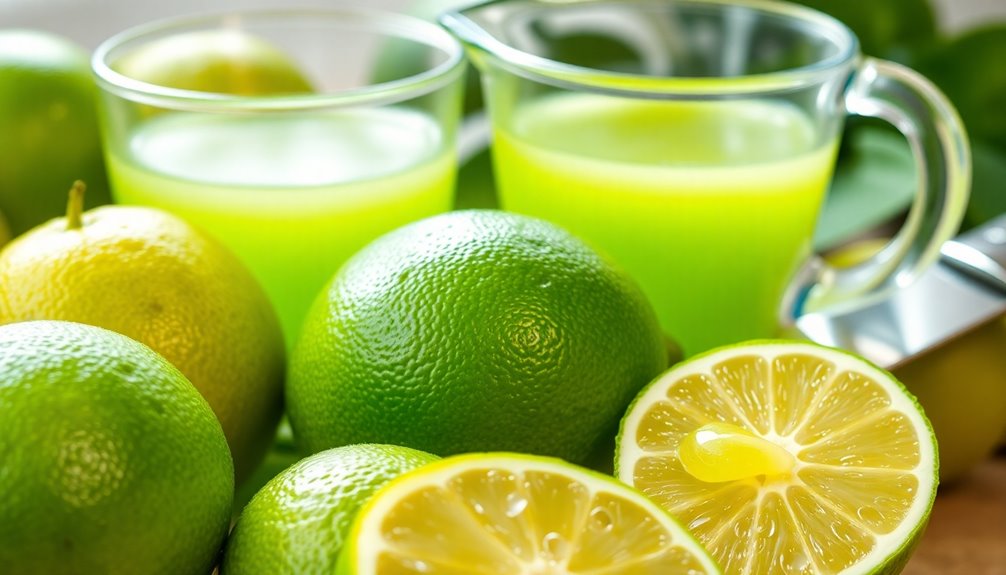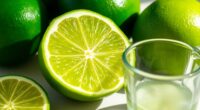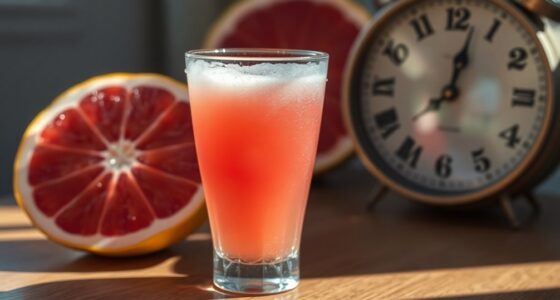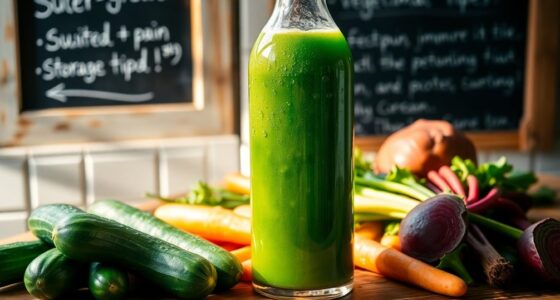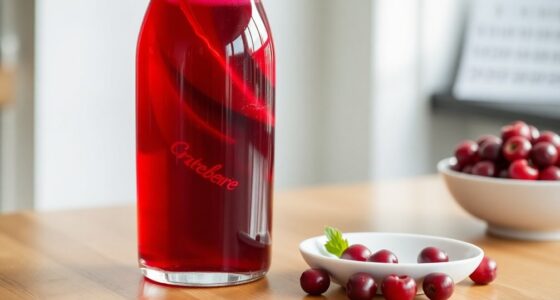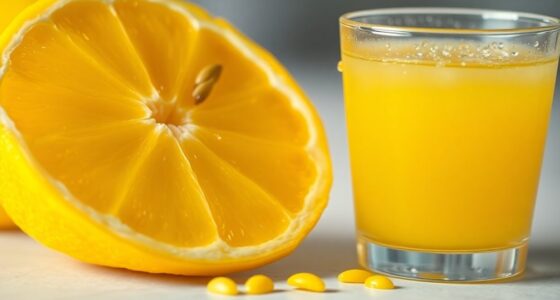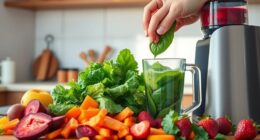To get 3/4 cup of lime juice, you'll need about 6 medium Persian limes or 10 to 12 Key limes. The amount can vary based on their size and juiciness, so it's always good to have a couple of extras just in case. For the best results, make sure to roll the limes before cutting them. There's more helpful info on getting the most out of your limes, so keep going to discover some great tips!
Key Takeaways
- For 3/4 cup of juice, you'll need about 6 to 8 medium Persian limes.
- If using Key limes, expect to use 10 to 12 limes for the same amount.
- Juicing efficiency can be improved by rolling limes on the countertop before cutting.
- Freshly squeezed lime juice enhances flavor in recipes like dressings and cocktails.
- Always have extra limes on hand in case some yield less juice than expected.
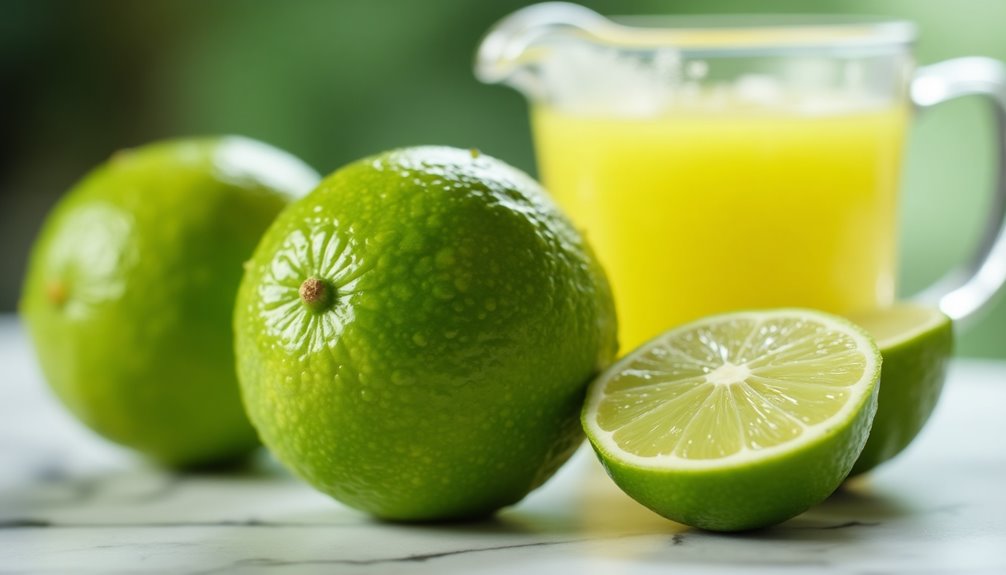
Have you ever wondered how many limes you need to squeeze for that perfect amount of juice? If you're aiming for 3/4 cup of fresh lime juice, the answer depends on the type of lime you choose and their size. For Persian limes, which are commonly found in grocery stores, you'll typically need about 6 to 8 medium limes. Each of these limes yields roughly 2 tablespoons of juice, so with a little math, you can see how they add up. If you're using a standard cup of lime juice, you'd require about 8 limes, but for 3/4 cup, you can comfortably stick to 6 limes.
Now, if you're a fan of Key limes, be prepared for a different game. Key limes are smaller and generally yield less juice—about 1 to 2 tablespoons per lime. Therefore, to reach that same 3/4 cup of fresh lime juice, you might need around 10 to 12 Key limes. It's a bit of a squeeze, but the flavor they offer is so unique that it can be worth the effort. Just keep in mind that the juiciness of limes can vary quite a bit depending on their ripeness and size.
Before you start squeezing, you can maximize juice extraction by rolling the limes on your countertop. This simple technique helps break down the internal structure, allowing more juice to flow out when you cut them open. Once you've rolled them, slice the limes in half and get ready to juice.
If you find that your limes are on the smaller side or not as juicy as you'd hoped, having an extra lime on hand can be a lifesaver. When you're counting how many limes to squeeze, it's worth noting that fresh lime juice is always preferred for its vibrant flavor and aromatic qualities.
Whether you're whipping up a zesty dressing, a refreshing cocktail, or a tangy dessert, the quality of your lime juice can make all the difference. Remember that the juicing process can be a bit messy. So, it's smart to have a bowl or a measuring cup ready to catch all that delightful juice. After squeezing, you can strain out any seeds or pulp if you prefer a smoother consistency.
Frequently Asked Questions
How Many Key Limes for 3/4 Cup Juice?
When you're juicing Key limes, you'll need about 12 to 15 to get 3/4 cup of juice. Each Key lime typically yields around 2 tablespoons, which adds up quickly.
You'll want to choose firm, heavy limes for the best results, since they contain more juice. Their unique flavor and acidity make them perfect for your recipes, so gather enough to achieve the right amount for your dish.
Happy juicing!
How Many Limes for 1 Cup of Juice?
When life gives you limes, you make lime juice!
To get 1 cup of fresh lime juice, you'll need about 8 medium-sized limes. If you grab smaller ones, aim for around 10 to 12, since they won't yield as much juice.
Fresh limes are best for that zesty flavor, so don't settle for bottled. Just squeeze them and enjoy the vibrant taste in your recipes!
How Much Juice Is in 3 Limes?
When you squeeze 3 limes, you can expect to get about 6 tablespoons of juice, which is roughly 3 ounces.
If your limes are medium-sized, you'll likely achieve this yield.
Keep in mind that the actual amount can vary based on the limes' freshness and size.
It's always smart to have an extra lime or two handy, just in case you need a bit more juice for your recipe.
Can I Use Regular Limes in Place of Key Limes?
Yes, you can use regular limes instead of Key limes, but keep in mind they'll change the flavor profile.
Regular limes are less acidic and milder, so your dish mightn't have the same tang. To get closer to the Key lime taste, try mixing the zest of both lime types and adjusting sweetness in your recipe.
Just remember, you'll need more regular limes to achieve the same juice yield as Key limes.
Conclusion
To whip up 3/4 cup of fresh lime juice, you'll need about 4 to 6 limes, depending on their juiciness. It's like squeezing sunshine into your drink! Remember, nothing beats the vibrant zing of freshly squeezed lime juice, so don't skimp on those limes. Next time you're mixing a cocktail or making a zesty dish, you'll know exactly how many limes to grab. Cheers to flavor-packed creations that'll have your taste buds dancing!
Cindy thoroughly researches juicing trends, techniques, and recipes to provide readers with practical advice and inspiration. Her writing style is accessible, engaging, and designed to make complex concepts easy to understand. Cindy’s dedication to promoting the advantages of juicing shines through her work, empowering readers to make positive changes in their lives through the simple act of juicing.

